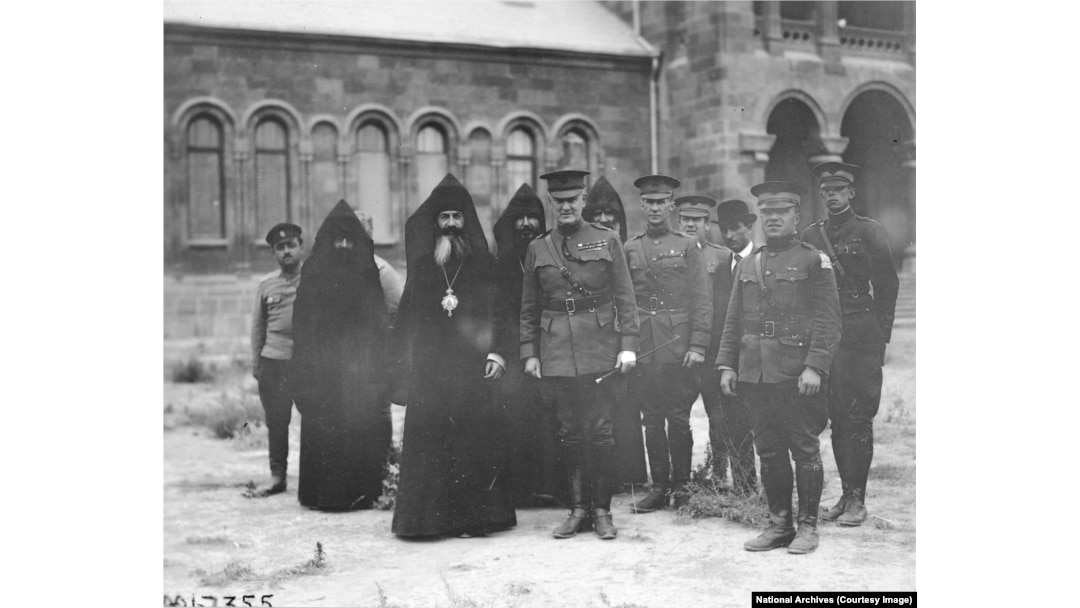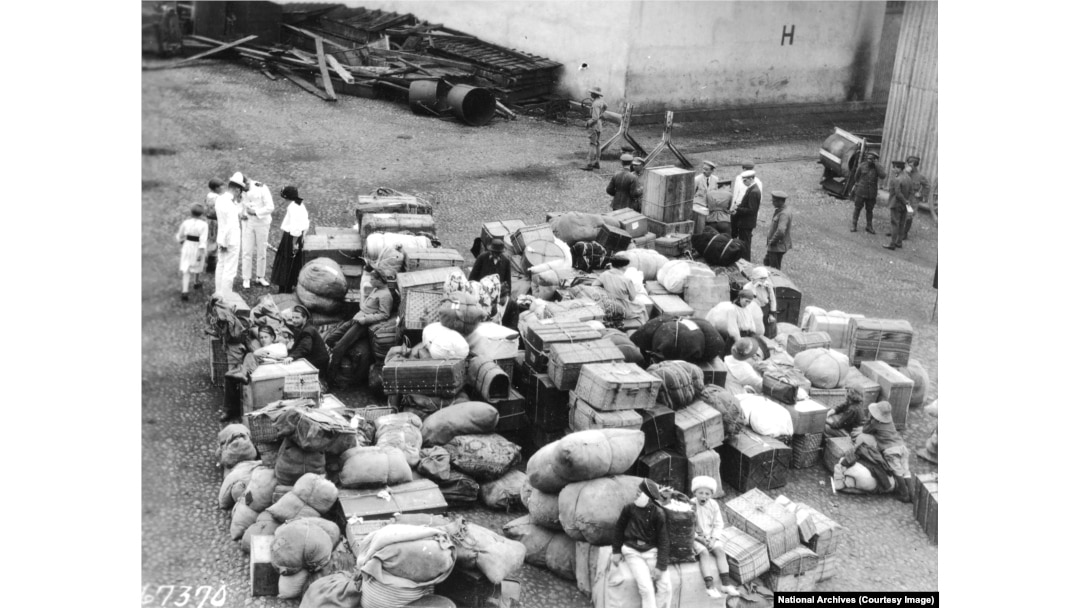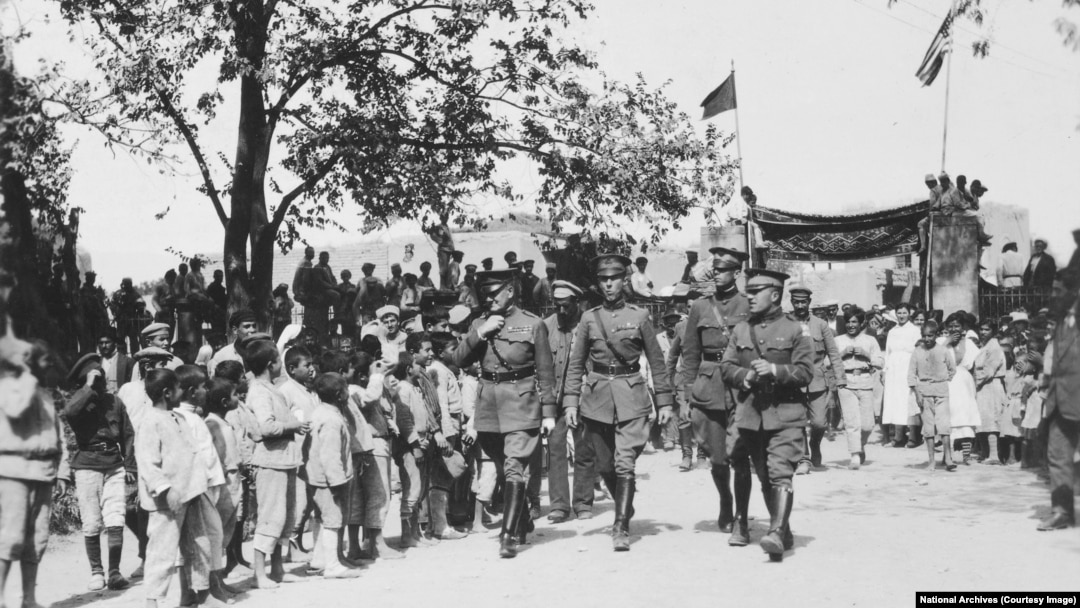With a single paragraph, American Major General James Harbord managed to capture at once the geopolitical uncertainty, lawlessness, and simmering ethnic hatreds of the Caucasus in 1919.
"In the region once policed by Russia, the relaxation from its iron hand has been great and life and property are unsafe in many regions," Harbord wrote. "Our mission was fired upon by Kurds in Russian Armenia and several motor cars struck by bullets, and over half the party were kept prisoner one night by Moslems who claimed to have been driven from their villages by Armenians."
The passage is from Harbord's Report Of The American Mission To Armenia, compiled after he led a fact-finding mission to a briefly independent Armenia following the collapse of both the Ottoman and Russian empires and before the country was captured by the Bolsheviks.

Major General James Harbord (center) poses with Armenian bishops in Echmiadzin in September 1919.
America, then under the presidency of Woodrow Wilson, sent Harbord to lead a 50-man team to Turkey and Armenia to "investigate and report on the political, military, geographic, administrative, economic, and such other considerations involved in possible American interests and responsibilities in the region."
Harbord's mission departed Istanbul in September 1919 then traveled by train and car through today's Turkey, Syria, Armenia, and finally Georgia.

Luggage belonging to the American expedition
A "bad place for autos" near the Euphrates River, probably in today's eastern Turkey in September 1919 during the American mission to Armenia
Accompanying Harbord's report, which sought to conclude whether an American mandate over the region was feasible, several dozen images made by a military photographer called Sergeant Barnes provide a rare glimpse into Armenia and Georgia's "First Republics."
The photos are now held in the U.S. National Archives.
Harbord (right) "inspecting an Arab's rifle" on the road through Turkish territory toward Armenia in September 1919
A Russian-built church seen by the expedition in "Sarikamish, Armenia," which today is a Turkish town. The church later had its spires removed and now serves as a mosque.
At the time of the American visit, Armenia, Georgia, and Azerbaijan had each declared their independence after a short-lived unification of the three countries into a single "Transcaucasian" republic had collapsed in 1918.
Armenian cavalry tasked with escorting the Americans. The photo was taken on September 27 as the party gathered to leave the "governor's palace" at Kars after a reception party.
Armenia in 1919 was a country ringed with conflict. In the west, ethnic Armenians had been largely wiped out through what one observer described as a nationwide Ottoman effort at "annihilating the Armenian race in the Turkish Empire."
In the north, Armenia fought with Georgia over disputed territory, and in the east, Armenian forces waged brutal battles over land with Azerbaijani forces and the Ottoman "Army of Islam."
Despite reeling from the Ottoman-era massacres, Armenia had captured large swathes of territory in eastern Anatolia in May 1919, just months before Harbord's mission arrived in the territory.
Kars, in today's eastern Turkey, seen in September 1919, when the fortress town was under control of Armenian forces
As well as the physical dangers he experienced during the trip, Harbord described the visible traces left of the massacres widely referred to as the Armenian genocide.
"Mutilation, violation, torture, and death have left their haunting memories in a hundred beautiful Armenian valleys, and the traveler in that region is seldom free from the evidence of this most colossal crime of all the ages," he wrote.
The Echmiadzin Cathedral
"Armenia," Harbord noted as an introduction to the country for his Washington audience, "was evangelized by Apostles fresh from the memory of our Lord, as early as 33 A.D., and as a nation adopted Christianity and founded a National Church in 301 A.D."
Harbord (seen adjusting collar on left) and other members of the mission enter a courtyard in Echmiadzin, a town just west of Yerevan. An American flag can be seen flying over the gate as part of the reception.
Armenian soldiers bring in a group of men described as "deserters from the Armenian army," in Yerevan.
The Hrazdan River seen flowing through Yerevan. Mount Ararat is visible in the background.
Using ethnic generalizations that were commonplace at the time, Harbord wrote that "the Armenian stands among his neighbors very much as the Jew stands in Russia and Poland, having as he does, the strong and preeminent ability of that race. He incurs the penalty which attaches among backward races to the banker, the middleman, and the creditor."
Yerevan's 18th-century Blue Mosque
Armed camel drivers seen in Armenia
Harbord ended his report by recommending a U.S. mandate over the region, which he said would require some 59,000 soldiers at the cost of $88.5 million in the first year. The force would be gradually pared down to an "irreducible minimum" over three years.
A residence in Yerevan described somewhat confusingly as "the building of the Prime Minister of the President of the Armenian Republic."
A street scene in Batumi, Georgia, near the end of the U.S. mission, which departed by ship from nearby Trabzon in October 1919.
In May 1920, U.S. President Wilson asked for authority to establish a mandate for Armenia, but the Senate rejected his request by a vote of 52 to 23.
Soon afterward, Armenia was invaded by both Turkey and the Bolsheviks. In 1922 the country was folded into the Soviet Union as a part of the Transcaucasian Socialist Federative Soviet Republic, along with Georgia and Azerbaijan.


